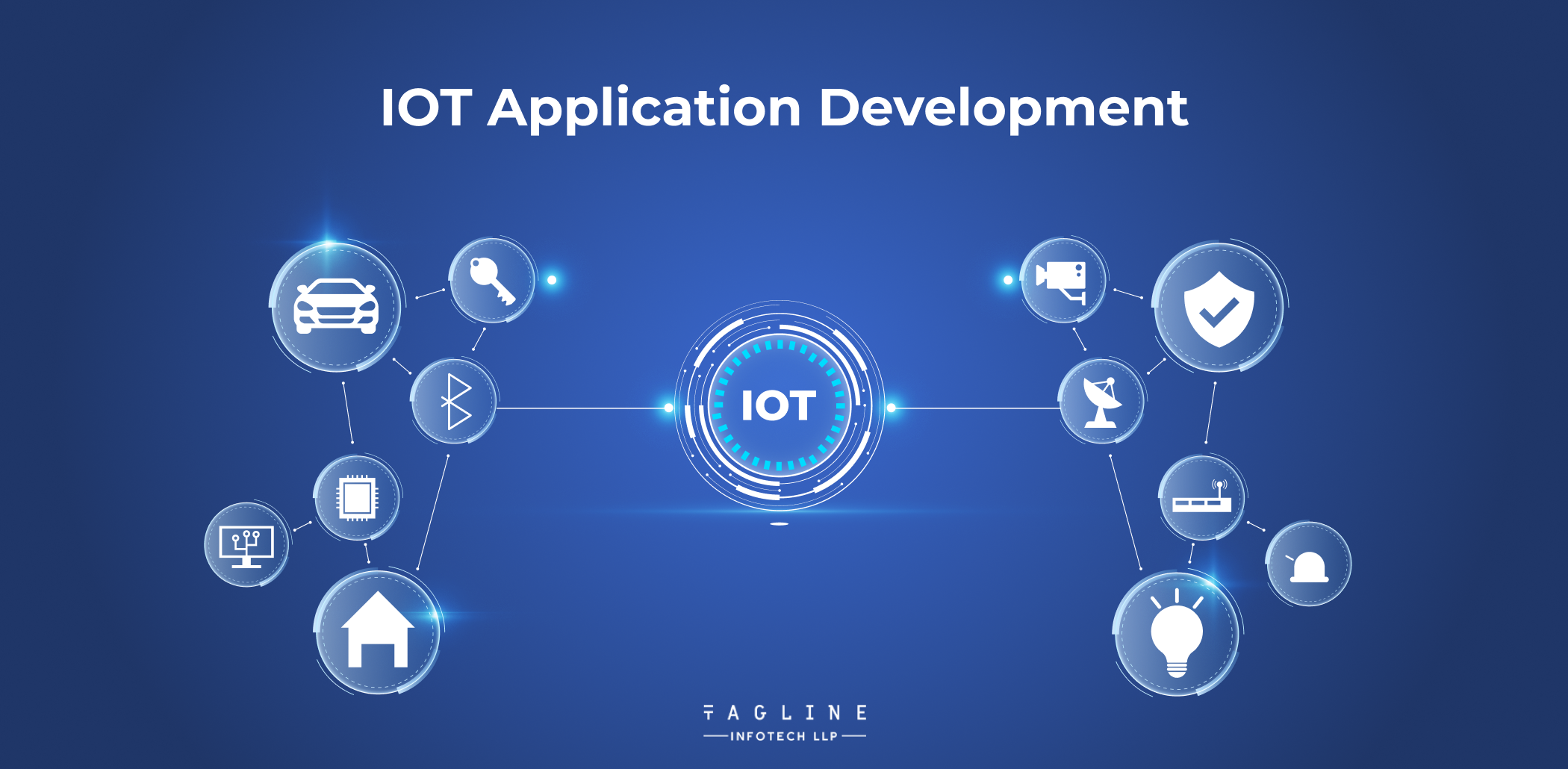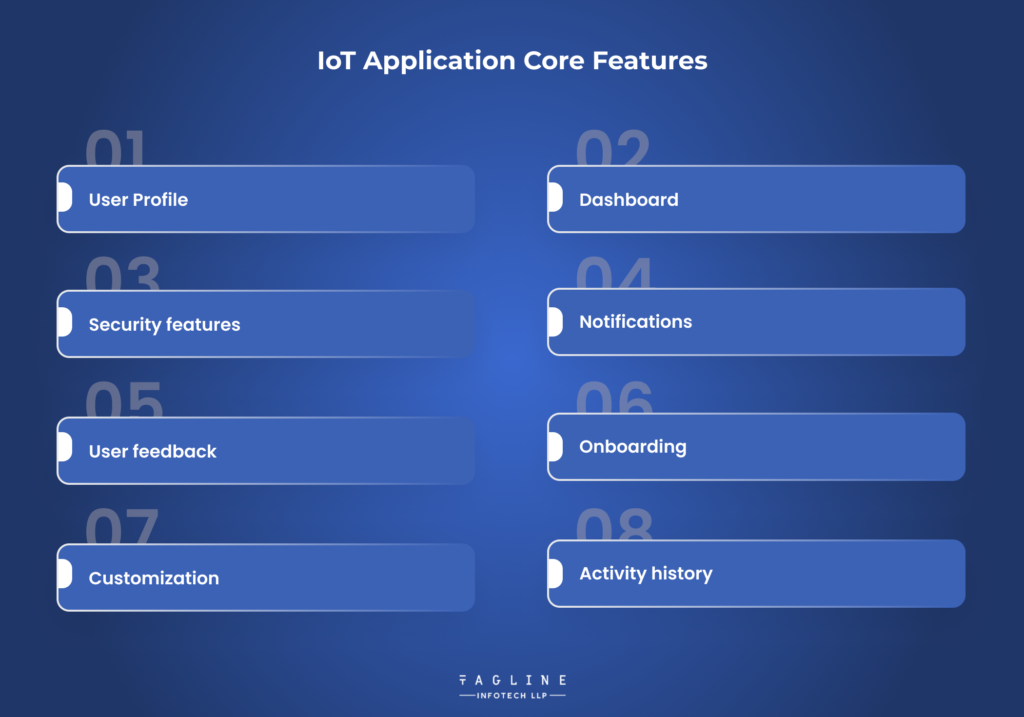The best AI-enabled hospital management system for your...
May 2, 2024
Home >> Mobile App Development >> IoT Application Development

Quick Summary
The Internet of Things is an incredible technological frontier. With consumers increasingly reliant on internet-connected devices, the demand for Internet of Things apps has skyrocketed. Developing Internet of Things (IoT) apps primarily aims to harness device data, analyze it, and provide users with pertinent information. If you’re a novice developer, the potential of IoT app development is boundless. Visit our blog to delve deeper into the world of Internet of Things apps.
Imagine, for a moment, a world where you have a smart thermostat seamlessly connected to both your heating and cooling systems and your smartphone. It’s capable of adjusting the temperature while you’re still in bed. Consider the convenience of pre-cooling your house to a comfortable temperature on a chilly, rainy day. This is the power of IoT apps, designed to enhance user experience and make life easier.
As for the information technology industry, we all know that demand is rising for IT services and goods, and one of the significant developments in app development right now is the development of Internet of Things applications. However, not many businesses understand how important it is to use the Internet of Things application development services. If you are a novice in the Internet of Things app development and want to produce the best possible IoT apps, you have come to the correct spot. We can help you with various aspects related to developing Internet of Things applications.
Input devices, also called sensors, are vital parts of any Internet of Things system. Sensors can collect important data, such as temperature or audio-video streams. A device’s main components are its numerous sensors, which collect and communicate environmental data.
Once the data is saved in the cloud, it is then upgraded by a software application. The software program gathers, examines, and arranges the information into meaningful categories.
This Internet of Things component helps the cloud infrastructure store and share data. The Internet of Things system does this through WAN, cellular, satellite, Wi-Fi, and other data transit networks.

The range of functionalities may vary significantly depending on the Internet of Things industry in which you operate, the end goals, and the user’s expectations. We created a list of necessary and optional characteristics for an Internet of Things application.
One crucial element of the systems linked to the Internet of Things is the user profile. Personalization is critical for intelligent apps, and building a highly customized, high-quality user experience requires getting to know your customers. Ask for all the necessary information, such as contact details, notification preferences, presence detection, security configurations, and privacy settings. Remind yourself to help add every smart device to the application. This function will even help your marketing team; if you have a firm grasp of your target audience, you can send them emails and push notifications corresponding to specific occurrences.
All of the data gathered is displayed on the dashboard, including information on bus arrivals, room temperature, and parking spaces that may be available. Depending on the kind of Internet of Things application you have, this is an important task that changes.
Access control, secure data transfer routes, and app locks such as FaceID or PIN-code are examples of security measures that can be incorporated into an application. It is hard to undervalue security measures when a significant amount of sensitive and personal data is being saved.
With the use of notifications, users may remain current and get alerts in real time about any changes. To give an example, motion sensors are used by smart doorbells to detect movement near the door and instantly send a notification to the user’s device.
The Internet of Things application can find areas for improvement and hear what customers have to say by asking for feedback from users. Users can report issues with applications by filling out a form that usually allows them to include a screenshot and provide details about the issue.
Essentially, onboarding is a series of panels designed to guide users through the application’s UI and main features. It is greatly desired for the user to have a more gratifying experience.
To enable quicker access to jobs and activities, customization options like shortcuts, routines, and stored devices can be employed. The user experience will be improved by expanding the items that can be changed.
The devices that have been activated or deactivated, their movements, and the actions that have been carried out within the program are all detailed in the activity history.
There are five simple steps involved in creating a mobile app from scratch that is compatible with the Internet of Things:
Having a strategic plan and determining your vision for your IoT solutions are prerequisites for developing Internet of Things (IoT) applications. You must choose whether you want a custom Internet of Things platform, and only then can you define your goals. Finally, you must decide if you’re going to use IoT application development services or not.
The user experience you offer is significantly impacted by the App Design you create. As a result, actively participate in and pay attention to this phase of the Internet of Things system’s growth.
Entrepreneurs can test their app concept with real users by creating a minimal viable product (MVP). Rather than being a mock-up, the Minimum Viable Product (MVP) is a complete and functional solution.
After launching your minimal viable product (MVP), you should focus on getting user feedback on the Internet of Things solutions and then appropriately improving them. Using the application itself to conduct a survey is the most straightforward approach.
After gathering input, you should examine the information and refine your Internet of Things platform. Yes, it’s time for the grand debut! Nevertheless, the hard work of your dedicated development team is not finished yet. Furthermore, they will help you with app updates and support once it is launched.
The following are some of the main benefits of creating Internet of Things applications:
However, even if the Internet of Things can be used in every industry, some industries require it more than others. The development of Internet of Things applications can be divided into five main categories.
Automation in homes and apartments enables you to operate appliances from a distance. Plugs and outlets that connect to your phone are also included, along with smart TVs, toasters, lightbulbs, air conditioners, heating systems, locks, speakers, and other Internet of Things solutions. the best example of Samsung Assistant App-SmartThings to automate home appliances easily.
The Internet of Things is used in the field of healthcare app development to keep an eye on devices and patients. Wheelchairs, oxygen pumps, defibrillators, insulin pumps, and other equipment of a similar kind are a few examples of such devices.
IoT technologies can help with both people and product movement in the field of logistics. Using GPS or satellite technologies, vehicles, warehouses, and goods may all be remotely controlled.
Smart cities, which are similar to smart houses but considerably more expansive, are the way of the future for urban living. An metropolitan area is being served by Internet of Things technology to improve the quality of life and efficiency of living there.
The Internet of Things (IoT) allows banks and other financial institutions to monitor and secure their physical locations, including automated teller machines (ATMs), by using real-time data from cameras, sensors, and other devices.
Furthermore, smart payment systems can be implemented thanks to Internet of Things devices, allowing users to safely and securely conduct contactless payments using their wearables and smartphones.
In the industrial industry, Internet of Things (IoT) devices link machinery and equipment to guarantee efficient production. Real-time data is captured by sensors mounted on production equipment, allowing for the execution of predictive maintenance and a reduction in downtime. This data-driven approach, which optimizes supply chain management, automates inventory tracking and boosts overall production efficiency, can help manufacturing organizations increase their overall production efficiency.
Insurance firms can more accurately evaluate risk thanks to the Internet of Things system, which collects data from connected devices like car telematics. Consequently, insurance policies may become more affordable and individually customized as a result.
The installation of digital sensors and devices in retail spaces is making shopping more pleasurable. It facilitates cashierless checkouts and helps with item location. Among the most well-known instances of this kind of grocery store is AmazonGo. Customers enter this experimental grocery shop, scan their unique QR code at the door, load their bags with their purchases, and then exit. The items that are included in customers’ bags are charged to their Amazon accounts via the Walk-Out system.
It requires a smooth approach, effective skills, and a thorough comprehension of hardware and software technologies, developing Internet of Things apps is crucial. It should not be surprising that the technology that is causing the biggest disruption to the conventional approach to application development is the Internet of Things. Consequently, the creation of mobile applications via the Internet of Things technology helps businesses boost the effectiveness and productivity of a range of business endeavors. Get in touch with us today to develop cutting-edge IoT applications and stay at the forefront of innovation.
IoT is a network of devices that connect to exchange data from devices and the cloud. These devices are integrated with technology like sensors and software that includes digital machines as well as user objects.
Different types of industries like healthcare, finance, transportation, logistics, and retail businesses can maximize the benefits of IoT app development solutions.

Digital Valley, 423, Apple Square, beside Lajamni Chowk, Mota Varachha, Surat, Gujarat 394101
+91 9913 808 2851133 Sampley Ln Leander, Texas, 78641
52 Godalming Avenue, wallington, London - SM6 8NW